#bokeh shape photography
Text
Quickly Capturing Lingering Light
Quickly Capturing Lingering Light #photography #poetry #vispo #dVerse
Lingering in Quickness by Maria L. Berg 2022
It’s amazing how energizing one cool, cloudy day was. Today, was back to hot and sweaty, but it didn’t feel as oppressive. I finally set up my new mobile mirrorworld to my satisfaction, and played with an interesting purple and green light palette.
And They Dance by Maria L. Berg 2022
I find it amusing that these random globs of dried hot glue in…

View On WordPress
#abstract art#abstract photography#abstractions#bokeh shape photography#Contradictory Abstractions#dVerse#dVerse poets#Italo Calvino#new poem
1 note
·
View note
Text
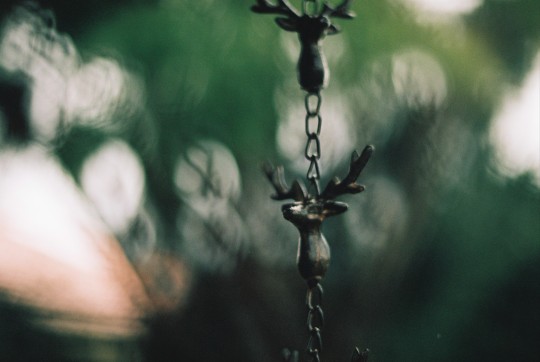
Unnamed (Not Untitled)
Sky Darcy Edwards
2022
Kodak 35mm film
Ricoh XR-10
Porst 55mm f/1.2
Custom boke shaping filter
#boke#bokeh#trans#trans artwork#names#sky#skydarcyedwards#stag#deer#filmphotography#film#35mm#kodak#porst#ricoh#ricohpentax#abstract#abstract photography#boke shapes#bokeh photography#film photography#experimental photography
13 notes
·
View notes
Text

Look deep into nature, and then you will understand everything better.
~ Albert Einstein
#photographers on tumblr#original photographers#photography#original photography#original photography blog#bokeh#nature#I used to be so fussy about my point of focus#but I’ve eased up on that#and I enjoy shapes and color blending a bit
8 notes
·
View notes
Text
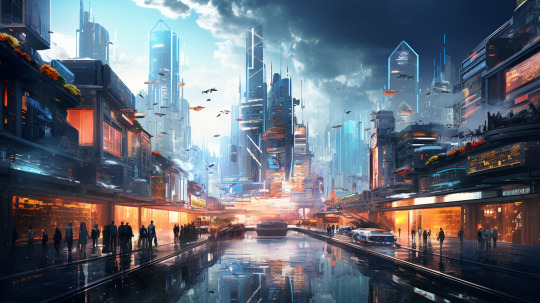
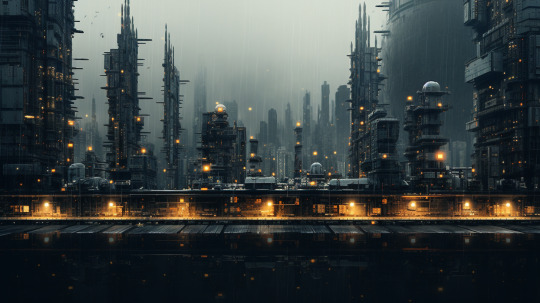


By Sandu
Prompt:
"Closeup architecture Minimalist night rain busy city scene floating granite ship space dock, azzuro amber forest, scifi wild, glass and steel industrial shiny metallic space station complex architecture into deep cloud environment, volumetric light, hot engines, huge air polygonal intake gates with shutters, living pastel color pods towering skyscrapers at cliff edge, jet era shapes, The 5th element,The Matrix,Craig Mullins,Syd Mead, eerie Sandu Baciu style, photography award, ultra realistic, wide angle, high detail, volumetric light at noon, Trending on artstation, Unreal engine hyper realistic photography award magazine cover -s 222"
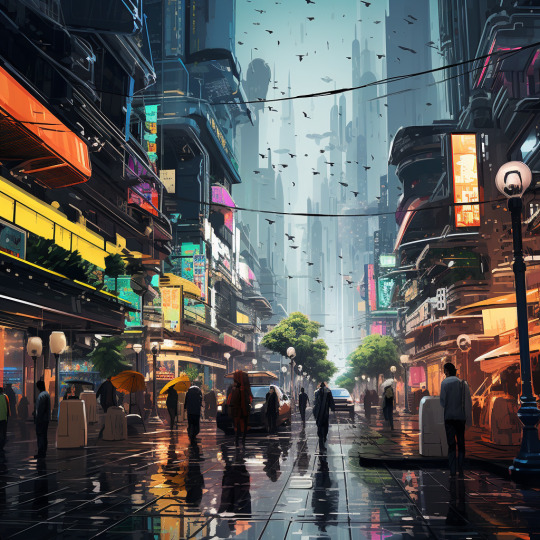
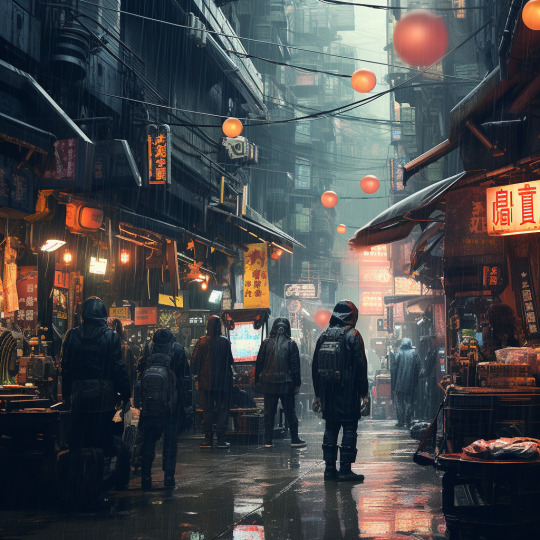



By Sandu
Prompt:
Mid day street scene futuristic asian market neon signs light strips Blade Runner rain pastel neon AR displays full body robot on plastic transpatent pastel clothes elegant white shinny ski jet jacket wet android police decals and stickers in pastel ski jaket scifi pockets zippers, walking american flag in space shuttele cockpit cap concept art basic droid blade runner rogue one, bokeh giant logo on chest, mecha pulp art humanoid robot schematics prints elegant ultra sci - fi robots droids fashion design, ultra modern scifi look, custom gorgeous inca wood inlay pulp art style elegant eerie sandu baciu brush painting comcept art blade runner style --s 222
#nestedneons#cyberpunk#cyberpunk art#cyberpunk aesthetic#cyberpunk artist#art#cyberwave#megacity#futuristic city#cryptoart#midjourney#ai artwork#ai artist#ai art#aiartcommunity#thisisaiart#cyberpunk inspiration#inspo#urban decay#eerie#promptsharing
174 notes
·
View notes
Text
TIPS 📸: Camera Basics - Aperture

Welcome to part three of the monthly tips article! This month we will be looking at the basics of a camera and we will continue with the aperture.
The aperture of a camera is a crucial setting that controls the amount of light that reaches the image sensor. It is indicated by an aperture symbol (e.g. f/2.8, f/4, f/8, etc.) and is one of the three main factors that influence the exposure of an image, along with ISO sensitivity and shutter speed.
The aperture is represented by a series of numbers such as f/1.4, f/2.8, f/4, f/5.6 etc., where a smaller number means a larger aperture. A large aperture (e.g. f/1.4) lets in a lot of light and results in a shallow depth of field. This means that the main subject is sharp, while the background or foreground is blurred. This effect is often used for portraits or artistic shots to make the subject stand out from the background.
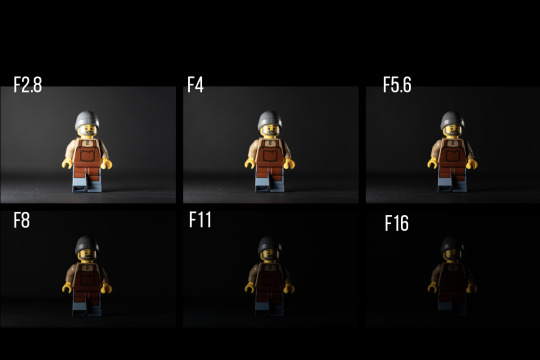
On the other hand, a small aperture (e.g. f/16) lets in less light and creates a greater depth of field. This means that both the subject and the background are sharp. Small apertures are often used in landscape photography to achieve a clear focus from foreground to background.

The depth of field created by a large aperture is often referred to as "bokeh". Bokeh refers to the aesthetic quality effect in the out-of-focus area of an image. The shape of the bokeh depends on the shape and number of aperture blades in the lens design. Round or hexagonal aperture blades typically produce soft, pleasing bokeh, while multi-edged shapes can result in irregular bokeh.
Overall, control over the aperture opening allows the photographer to not only control the exposure, but also to creatively shape the image by controlling the depth of field and the aesthetics of the bokeh. It is important to use the aperture selection consciously in order to achieve the desired photographic results.
If you're interested in more details and tips, have a look at @takebettertoyphotos there you'll find great instructions and articles about it!
See you soon!
@joschka-vanderlucht
20 notes
·
View notes
Text
last season's anime: that elf show (1-6)
Belatedly watching Sousou no Frieren, the darling of the... previous anime season four months ago. So old news as far as most are concerned!
I have held off on watching this one because, well, videogamey elves-and-dwarves European fantasy is ehhhhhh! I can get into it if it's really well done and puts the focus somewhere interesting (c.f. Dungeon Meshi), or if its medievalism is a bit more historically grounded than your average videogame-inflected fantasy anime (actual European history is full of fascinating/fucked up shit which rarely makes it into fantasy). But Frieren didn't strike me as having that vibe.
Nevertheless I heard Madhouse were the ones that did it and somehow that was enough to finally tip me over into watching it. So lol. I was a baby or even an ovum when Madhouse were doing most of their best known work, and yet...
Anyway, it turns out, not only was it a Madhouse project, but none other than Yoshiaki Kawajiri actually boarded a good few of the episodes, although he's not the enshutsu [episode director/storyboarder] whose people are most excited about. The series director's last work was Bocchi the Rock after all! And this sure is another hit.
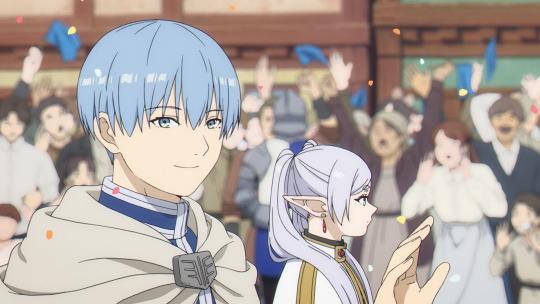
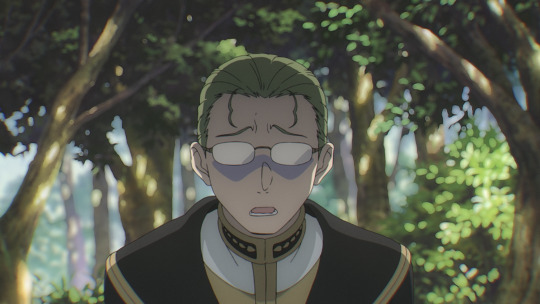

The first two things that jumped out at me in the first episodes were: the bgs are insanely good looking and the photography department is absolutely in love with a digital bokeh filter. I don't think I often see this specific kind of blur filter in anime (though I think you'll see it the works of some directors who like to emulate realistic photography like Yamada or Shinkai), and it was interesting the effect it had of eliding the lines and creating an effect kind of similar to posterisation.
Bokeh aside, the background painting and layouts in this anime are really incredibly good. When I occasionally watch fantasy anime - I have a friend who is quite into isekai and will occasionally show me one of her faves such as Ascendance of a Bookworm - one thing that often bothers me is the architecture, you have identical box-shaped houses with big windows, wide flat streets, it generally doesn't feel like a lived-in city. This is something that particularly bothers me about Attack on Titan.
By contrast, Frieren is routinely dropping scenes like this:
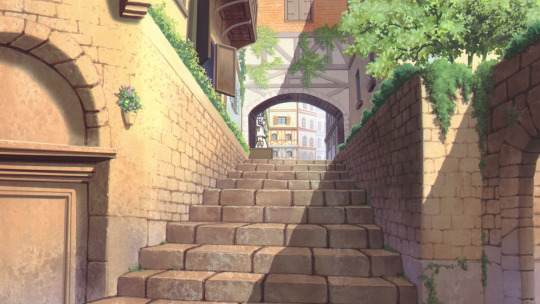
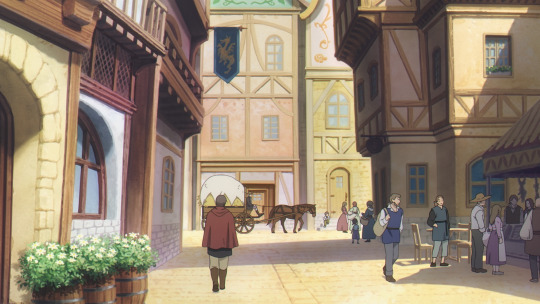

Split levels, varied colours and heights, accurate depiction of features like jettying, mixing up the verticals a bit. It's an impressive attention to detail and it does so much to sell the setting.
And the nature scenes are outstanding as well. Although I'm pretty sure they're painted digitally, it has the feeling of older physical media. The bg painters clearly understand the power of hinting at form with brush stroke shapes and a few flat colours - a technique similar to the bg paintings at Ghibli. There's rarely an obvious digital texture and they exercise restraint in overwhelming everything with glows and flares. The flat colours and paint-like textures are allowed to shine on their own. Plus everything has a subtle grain (pretty sure it's just good old Perlin noise), adding to the analogue feel.
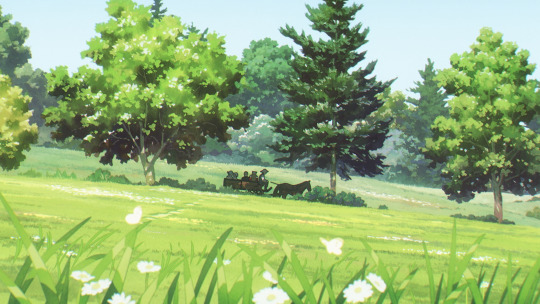


But yeah, look at the subtle atmospheric perspective in the last one there! The layers of forest in the background are painted with less saturated colours, creating a powerful sense of layering and distance, without having to draw more trees than the immediate foreground. I could learn a lot from this painting alone when it comes to forest scenes.
While I'm going on about technical stuff, the animation also stands up. The first episode in particular has some real flexes with crowd scenes containing dozens of moving characters. The character animation is generally very restrained, but naturalistic. There is constantly a strong sense of space. The action animation later does less for me - it's not at all bad, but it's within the conventions of modern shounen adaptations - but it's generally speaking strong.
All that said, what about what it's actually, y'know, about?
Frieren wastes little time in establishing its premise. The title character is a nigh-immortal elf, who was part of the RPG party that defeated the demon lord just prior to the outset of the show. Frieren has a pretty flat affect in general - not to say she's emotionless, far from it, but rather the heavy lifting of what she's feeling has to be conveyed through cinematography and implication of her actions. Though that said, it does plenty to humanise (elfise?) her too - she is not a morning person, and there are moments where she will get visibly excited about small things. Mostly, Frieren is a character who really doesn't understand herself very well.
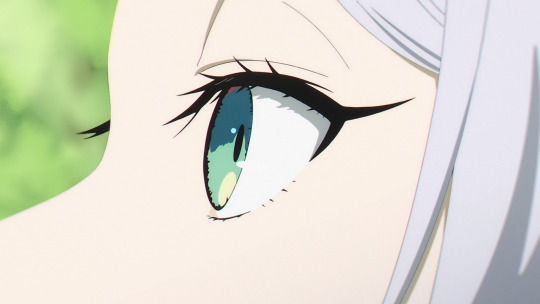
Comparisons to the prototypical emotionaless girl Rei Ayanami come to mind to me - especially the version of Rei we encounter in Eva 3.0+1.0. Both characters' affect is shaped by transience - for Rei, she's a short-lived clone, for Frieren, her perception of time is completely miscalibrated to all the people around her so she'll accidentally disappear for decades while they get old and die. And both characters' arcs involve learning about how to understand human connections.
As kvin has said in his impressively detailed article on the background to this show, this premise is used to tell a story about the passage of time. In the specific, it's about the grief of realising you did not spend enough time with someone after they've gone. Frieren is retracing the steps of the party after disappearing from their lives for nigh on 50 years, returning just in time to catch the human characters as they die of old age. The episodes are usually constructed around her memory of that adventure, paralelled by the connection she's forming in the present with her new apprentice. She's trying to do things that she never managed to do when they were alive, get in touch with her own feelings, etc. etc. Lots of mono no aware in the air.
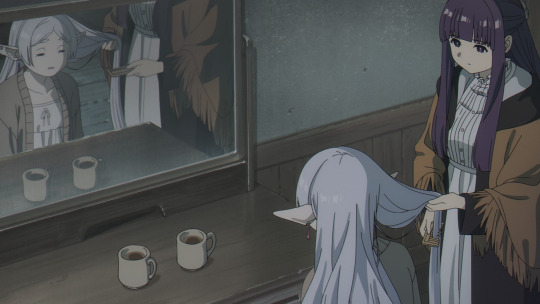
So each episode tends to develop two stories in parallel. There will be the immediate impetus - Frieren and co. find something that needs dealing with and coincidentally links back in to the past - and also flashbacks which help flesh out the rest of Frieren's party and why the journey was such a big deal to her. The writing and editing generally does a very good job of knowing what to leave unstated, what can be implied by a cut and a closeup.
More than anything I think I'm reminded of Seirei no Moribito. Frieren herself reminds me a little of Balsa - they're quite different characters, but the way they relate to others and the general arc of being changed by their connections - and while the dynamic between her and Fern is a little less parental than Balsa and Chagum, the use of scenery and the general approach to setting up of episode plots feels quite similar.
Predictably, stories about grief touch a nerve! 'I didn't properly appreciate the time I had with her' is something I feel particularly with my friend Fall, who we lost nearly two years ago now. A story about figuring out just what someone meant to you after they are gone is resonant, shall we say.
The first and second episodes as a pair end up particularly affecting. I talked about the technical stuff above, but the editing is also really strong. A couple of moments that stood out to me: moment of ephiphany communicated with a sudden eye closeup, an L-cut to bells which you don't hear until there's been another cut to the actual funeral. Since I've been in the sakugabooru server I've been learning to pay a lot more attention to individual enshutsu, so the names to credit in this case are Saito himself for the first, and Tomoya Kitagawa for the second.
The third episode (Daiki Harashina) stumbles a bit in my view, not so much because of the direction but because the script brings in some less-interesting magic mechanics and fighting-a-demon elements. The fourth episode, the first directed by Kawajiri, falls back into the rhythm: the stakes are small but we feel the development of Frieren and Fern's dynamic.
The fifth (Kenichi Shimizu) and sixth (Toru Iwasawa) episodes are a two part story, introducing a new character Stark as a second young apprentice character - the sixth episode has a really exceptional action scene with its dragon fight, bringing in a lot of familiar action animator names, and moreover the preceding episode does the work to set it up so we're invested in the culmination of the character arc it represents! Also there's that one sitting down cut I heard about. I wasn't sure I'd be on board with Stark at first, but he's growing on me through his interactions.
By this point we're starting to have more present-day 'villagers have a monster problem' type setups, but they're still primarily instruments to advance characterisation: the conflict of Stark with cowardice and responsibility is paralelled by one of Frieren's former party members, Frieren and Fern get to face ghosts of people they've lost, etc.
The first few episodes jump forward in years at a time in between, and even within the episodes tend to elide huge periods of time with montages - very effective for driving the central theme of tiiiiime. That seems to be slowing down a little now, although we'll see.
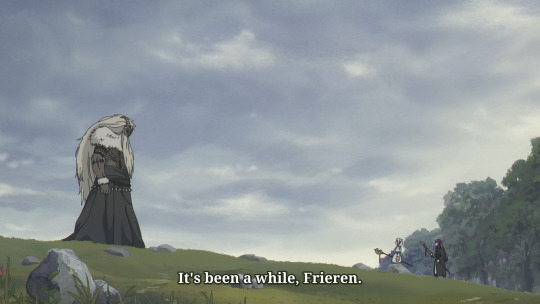
I think if anything weakens it, it's that the demons and monsters feel undercooked as setting elements - and I'm a little worried by hearing that they become increasingly central elements as the show goes on. Of course, they're kinda mandated by the RPG setting, and being able to just say 'back when demons attacked the village' lets the show put its time into characterisation. But to take episode 3 for example - surely there is drama to be had in the idea of a senior underling who was frozen for nigh eighty years, unaware that his master had been overthrown? But nah, he just attacks immediately, and then it turns out that human magic science has advanced so much building out from his technique that he's not a big deal anymore (ratfic ass concept). Mostly demons and monsters exist as plot devices, opportunities for characters to prove themselves or experience an epiphany.
It's a shame because the show goes to such enormous lengths to flesh out everyone else's motivations. 'Why did character x do or feel y' is kind of the thrust of every episode (c.f. that kinda questionable stuff people say about JP storytelling being more about causality than conflict). Next time they supply us a demon character, I hope they're willing to give them a comparable treatment. 'Kind, peace-loving villagers vs ontologically evil baddies' is just such a boring dynamic, and with such love poured into everything else, it seems a shame.
Overall, I don't think Frieren is going to displace Tengoku Daimakyou as my fave of 2023, or stand alongside Dungeon Meshi as elves-and-dwarves fantasy goes, but it's definitely a memorable one. As an adaptation it's absurdly strong. Looking forward to watching the rest.
21 notes
·
View notes
Text
"📸✨ Elevate your photography game with our guide to mastering the enchanting Bokeh Effect!
Dive into lens mastery, dreamy apertures, and creative bokeh shapes.
Explore further at HOWYOUDONE Follow for tips, like to show love, and share the magic! #BokehMagic #PhotographyTips"
#photography#photoshoot#bokeheffect#best photography#camera#camera lens#nature#landscape#potrait#photograph#candid
2 notes
·
View notes
Photo
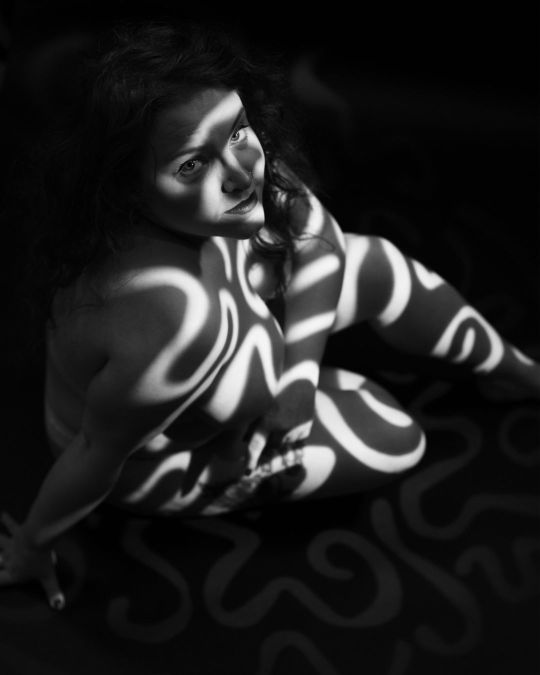
“The human body is the best work of art.” ― Jess C. Scott How cool is @disastersequins? So she had the idea for a shoot where abstract shapes were cast onto her body and asked if I'd be interested. Of course I was! A few bits of equipments and one very fun Sunday later and here we are. It's great to branch out. It's even greater to work with awesome people. #photography #portraitphotographer #portraitphotography #photographer #glasgowphotographer #blackandwhitephotography #b&w #b&wphotography #bodyart #gobo #shadows #modelphotography #universityofglasgow #christmaslights #bokeh #theportraitobjective #boundlessphotography https://www.instagram.com/p/Cn7nb9OtVEw/?igshid=NGJjMDIxMWI=
#photography#portraitphotographer#portraitphotography#photographer#glasgowphotographer#blackandwhitephotography#b#bodyart#gobo#shadows#modelphotography#universityofglasgow#christmaslights#bokeh#theportraitobjective#boundlessphotography
14 notes
·
View notes
Text
HOW TO CREATE BOKEH IN STUDIO
BOKEH
Bokeh is a very popular photographic effect referring to the aesthetic quality of an out of focus area in the image. Bokeh can have different appearances. Smooth round dots as Robert used in his sample. Multi‐sided geometric shapes like hexagons, caused by the number of blades in the lens, and everything in between.
BOKEH PHOTOGRAPHY TRIAL AND ERROR TIPS:
1. Set up (or find) a background…

View On WordPress
#beauty products#bokeh#bokeh photography#difficult background#ecommerce photography#photoshop tutorials#professional photographer#professional photography
2 notes
·
View notes
Photo

When to Use Bokeh Effects
Bokeh is a Japanese word that means blur or haze. Bokeh is a decorative technique used in photography to give an image a blurred, elliptical shape or look.
#mohitbansalchandigarh#chandigarh#photography#chandigarhphotography#pixels#boken#technique#effects#Japaneseword#blurredphotography#image#trickyphotography#backgroundeffect#effect#mohitbansal#photoshoot
1 note
·
View note
Text
The Values of Literature
The Values of Literature #photography #poetry #vispo #dVerse
Gathered Feathers by Maria L. Berg 2022
Last week I stumbled upon Italo Calvino’s Six Memos for the Next Millenium which are a series of planned lectures about literary values he was working on when he died. He died before he finished writing the sixth. His six values of literature are: Lightness, Quickness, Exactitude, Visibility, Multiplicity, and Consistency.
In each of his lectures he…

View On WordPress
#abstract art#abstract photography#abstractions#bokeh shape photography#Contradictory Abstractions#dVerse#dVerse poets#Italo Calvino#new poem#The Six Memos
0 notes
Text
Capturing Culinary Delights: Tips for Stunning Food Photography
In the visually driven world of social media and digital marketing, the art of food photography has become more important than ever. From enticing menus to mouthwatering social media posts, captivating food photography can elevate the appeal of culinary creations and entice hungry customers. As a leading platform for culinary exploration, Hungr's understands the power of stunning food photography to tantalize taste buds and spark curiosity. In this guide, we'll share expert tips and techniques for capturing culinary delights that are sure to make your audience drool.
1. Lighting is Key
The foundation of any great food photograph is impeccable lighting. Natural light is often the best choice for showcasing the vibrant colors and textures of your dish. Position your subject near a window or outdoors to take advantage of soft, diffused light. Avoid harsh shadows by using reflectors or diffusers to control the intensity of the light and create a flattering, evenly lit scene.
2. Composition Matters
Composition plays a crucial role in food photography, helping to draw the viewer's eye to the most appealing elements of your dish. Experiment with different angles, perspectives, and arrangements to find the most visually striking composition. Consider the rule of thirds, leading lines, and negative space to create dynamic and balanced compositions that highlight the beauty of your food.
3. Focus on Details
The devil is in the details when it comes to food photography. Showcase the texture, shape, and intricate details of your dish by getting up close and personal with your subject. Use a shallow depth of field to create a beautiful bokeh effect that emphasizes the main focal point of your photograph while gently blurring the background for added depth and dimension.
4. Play with Props and Backgrounds
Props and backgrounds can add depth, context, and personality to your food photographs. Experiment with different surfaces, textures, and colors to create visually compelling backdrops that complement your dish. Incorporate props such as utensils, napkins, herbs, or ingredients to enhance the story-telling aspect of your photograph and create a sense of ambiance and authenticity.
5. Tell a Story
Great food photography goes beyond simply capturing a beautiful image; it tells a story and evokes emotion. Consider the narrative you want to convey with your photograph and use composition, lighting, and styling to bring that story to life. Whether it's the warmth of a cozy kitchen, the hustle and bustle of a bustling restaurant, or the serene beauty of a farm-to-table meal, infuse your photographs with personality and narrative depth.
6. Experiment and Have Fun
Don't be afraid to experiment and think outside the box when it comes to food photography. Try different angles, lighting setups, and editing techniques to discover what works best for your style and subject matter. Above all, have fun and let your creativity shine through in your photographs.
Conclusion
With these expert tips and techniques, you'll be well on your way to capturing stunning food photographs that tantalize the senses and leave your audience craving more. Whether you're a professional photographer, a food blogger, or a passionate home cook, the art of food photography offers endless opportunities for creativity and expression. So grab your camera, whip up something delicious, and let your culinary creations shine in front of the lens!
At Hungr's, we believe in the power of beautiful food photography to inspire and delight. Join us on a journey to explore and discover the next big shift in food tech. To know more call us at +91 8042076111 / +91 9583339530 email us at [email protected] or visit https://hungrs.com
1 note
·
View note
Text
The Ultimate Professional Photography Equipment List

In the world of photography, equipment plays a pivotal role in capturing the perfect shot. Whether you're a seasoned professional or an aspiring enthusiast, having the right gear can make all the difference in achieving stunning results. From cameras to lenses, lighting to accessories, the options can seem overwhelming. That's why we've compiled the ultimate professional photography equipment list to guide you through the essentials of what you need to take your photography to the next level.
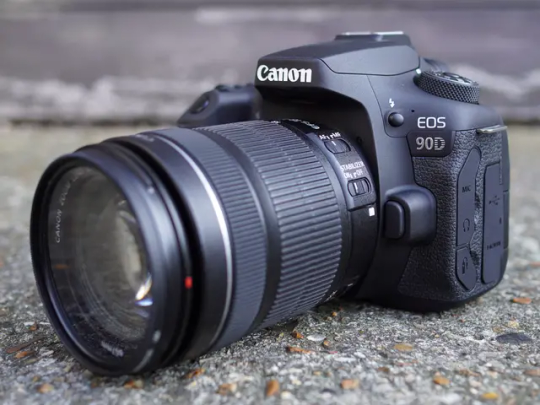
Cameras
DSLR Cameras Digital Single Lens Reflex cameras remain indispensable tools for professional photographers due to their versatility and exceptional image quality. They offer versatility, high image quality, and interchangeable lenses. Popular models include Canon EOS 5D Mark IV and Nikon D850.
Mirrorless Cameras: These compact and lightweight cameras offer similar image quality to DSLRs but without the bulky size. Sony Alpha series and Fujifilm X-T4 are renowned for their performance and portability.
Medium Format Cameras: Ideal for studio and landscape photography, medium format cameras like the Phase One XF IQ4 deliver exceptional detail and resolution, making them a favorite among commercial photographers.
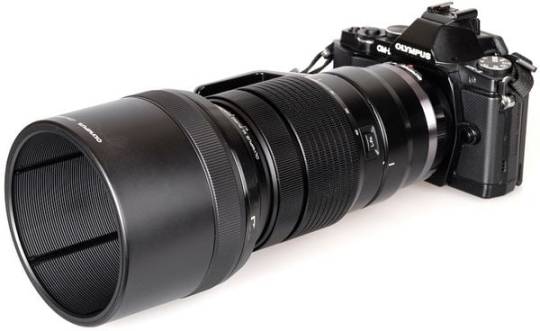
Lenses
Prime Lenses: Known for their sharpness and wide aperture, prime lenses like the Canon EF 50mm f/1.2L and Nikon AF-S NIKKOR 85mm f/1.4G are perfect for portraits, low-light situations, and achieving beautiful bokeh.
Zoom Lenses: Offering versatility, zoom lenses like the Canon EF 24-70mm f/2.8L II and Sony FE 70-200mm f/2.8 GM are great for capturing a variety of subjects, from landscapes to events, with minimal lens changes.
Macro Lenses: Designed for close-up photography, macro lenses such as the Nikon AF-S VR Micro-NIKKOR 105mm f/2.8G are essential for capturing intricate details and capturing stunning images of small subjects like flowers and insects.
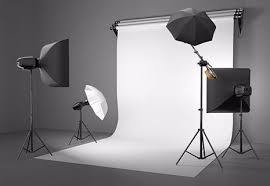
Lighting
Speedlights: Portable and versatile, speedlights like the Nikon SB-5000 and Canon Speedlite 600EX II-RT provide on-camera and off-camera lighting solutions for various shooting conditions.
Studio Strobes: For professional studio setups, studio strobes such as the Profoto D2 and Godox AD600Pro offer consistent and powerful lighting for studio portraits, product photography, and fashion shoots.
Modifiers: Light modifiers like softboxes, umbrellas, and reflectors help control and shape light to achieve desired lighting effects, such as softening shadows or creating dramatic highlights.
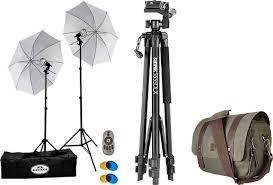
Accessories
Tripods: Essential for achieving stability and sharpness, tripods such as the Manfrotto MT055XPRO3 and Vanguard Alta Pro 263AB provide a sturdy base for long exposures, landscape photography, and self-portraits.
Camera Bags: Protect your gear while on the go with durable and functional camera bags like the Peak Design Everyday Backpack and Lowepro ProTactic series, featuring customizable compartments and weather-resistant materials.
Memory Cards: Invest in high-speed and reliable memory cards like SanDisk Extreme Pro and Lexar Professional to ensure fast write speeds and ample storage for high-resolution images and 4K video recording.
Filters: Enhance your photography with filters such as polarizers, ND filters, and graduated neutral density filters to control reflections, reduce glare, and balance exposure in challenging lighting conditions.
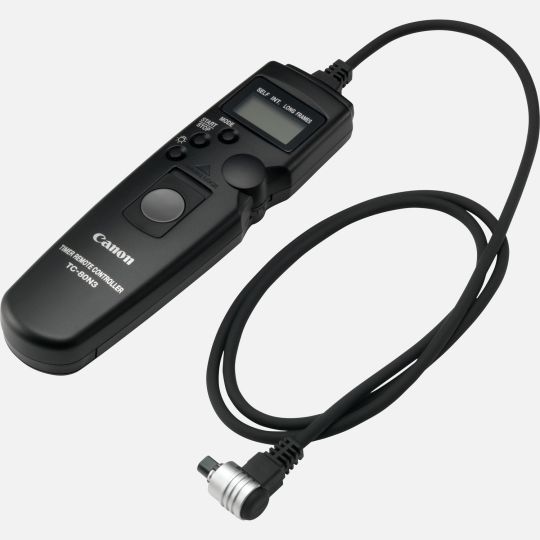
Post-Processing Tools
Editing Software: Adobe Photoshop and Lightroom are industry-standard software for editing and retouching images, offering powerful tools for adjusting exposure, color, and composition.
Calibration Tools: Ensure accurate colors and tones with monitor calibration tools like Datacolor SpyderX and X-Rite ColorMunki, essential for maintaining consistency across different devices and print outputs.
Storage Solutions: Back up and organize your digital assets with reliable storage solutions such as external hard drives, NAS (Network Attached Storage), and cloud storage services like Dropbox and Google Drive.
Conclusion
Building a comprehensive photography kit involves careful consideration of your artistic vision, shooting style, and budget. While the options may seem endless, investing in quality equipment that suits your needs can significantly enhance your photography experience and the quality of your work. Whether you're capturing breathtaking landscapes, timeless portraits, or compelling commercial imagery, having the right tools at your disposal is essential for achieving your creative vision. So, equip yourself with the essentials from our professional photography equipment list and embark on a journey of endless possibilities in the world of photography.
0 notes
Text
Types of Camera Lenses: A Complete Guide
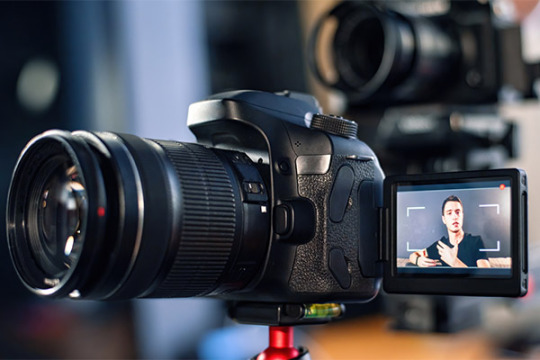
The world of photography is filled with fantastic tools, and the lens is arguably the most crucial one. It's the gateway through which light reaches your camera's sensor, shaping the final image. But with so many varieties available, choosing the right lens can be daunting. Fear not, photography enthusiasts! This comprehensive guide will break down the different types of camera lenses and their uses.
The Two Main Categories: Prime vs. Zoom
Prime Lenses: These lenses offer a fixed focal length, meaning you can't zoom in or out. However, they come with several advantages:
Sharper Images: Prime lenses typically produce sharper, higher-quality images because their design is simpler.
Faster Apertures: Prime lenses often boast wider maximum apertures, allowing more light to enter for beautiful low-light photography and shallow depth of field effects (blurred backgrounds).
Lighter and More Compact: Their fixed focal length makes them smaller and lighter, ideal for travel and everyday use.
Zoom Lenses: These versatile lenses provide a range of focal lengths, allowing you to zoom in and out for greater compositional flexibility. They're perfect for situations where you need to capture various elements from wide landscapes to distant subjects. However, zoom lenses generally:
Offer slower apertures compared to prime lenses at similar focal lengths.
May produce slightly less sharp images due to their complex design.
Tend to be heavier and bulkier.
Diving Deeper: Focal Length and Specialty Lenses
Focal length is the distance between the lens's optical center and the image sensor. It significantly impacts the field of view (how much of the scene is captured) and the perspective of your image. Here's a breakdown of common focal length categories and their applications:
Wide-Angle Lenses (14mm-35mm): Capture expansive scenes, ideal for landscapes, architecture, and astrophotography.
Standard Lenses (35mm-85mm): Replicate the natural perspective of the human eye, great for everyday photography, portraits, and street photography.
Telephoto Lenses (85mm and above): Bring distant subjects closer, perfect for wildlife, sports photography, and portraits with a compressed background effect.
Beyond Basics: Specialty Lenses for Specific Needs
Macro Lenses: Designed for extreme close-up shots, revealing intricate details in flowers, insects, and tiny objects.
Fisheye Lenses: Capture a super-wide, distorted field of view for creative effects.
Tilt-Shift Lenses: Create a miniature effect by selectively blurring parts of the image, often used for architectural photography.
Choosing the Right Lens for You
The best lens depends on your photography style and budget. Here are some tips:
Beginners: Consider a versatile zoom lens to explore different focal lengths.
Landscape Photographers: Look for wide-angle lenses to capture vast scenes.
Portrait Photographers: Prime lenses with wider apertures are great for beautiful bokeh (background blur) and low-light portraits.
Remember, the lens is your creative partner. Experiment, explore different types, and discover the ones that help you achieve your photographic vision!
0 notes
Text
The Iconic Legacy of Leica Cameras
Since its inception in 1914, Leica Camera AG has been synonymous with innovation, precision, and excellence in photography. With a rich heritage spanning over a century, Leica has solidified its position as a pioneer in the world of photography, shaping the way we capture and perceive images.
Renowned for their exceptional craftsmanship, Leica cameras are revered by professionals and enthusiasts alike. Each camera is meticulously handcrafted in Germany, blending cutting-edge technology with timeless design. The iconic red dot emblem symbolizes not just a brand, but a commitment to quality and artistry.
One of Leica's most enduring legacies is its role in the development of 35mm photography. The introduction of the Leica I revolutionized the industry, offering photographers unprecedented portability and versatility. Londoncamerahub innovation laid the foundation for modern-day photography, influencing the design of countless cameras to come.
Leica's commitment to optical excellence is evident in every lens they produce. Renowned for their exceptional sharpness, clarity, and bokeh, Londoncamerahub Leica lenses are cherished by photographers seeking uncompromising image quality. Whether capturing landscapes, portraits, or street scenes, Leica lenses consistently deliver breathtaking results.
Beyond their technical prowess, Leica cameras hold a special place in photographic history due to their association with iconic photographers. Legends like Henri Cartier-Bresson, Robert Capa, and Annie Leibovitz have all relied on Leica cameras to capture some of the most defining moments of the 20th and 21st centuries.
In the digital age, Leica continues to push the boundaries of innovation with cameras like the Leica M and SL systems. These cameras combine the heritage of traditional craftsmanship with the latest advancements in digital technology, offering photographers unparalleled creative freedom and control.
Whether shooting on film or digital, Leica Camera inspire photographers to see the world differently, encouraging them to push the limits of their creativity. As we look to the future, one thing remains certain: the legacy of Leica will continue to shape the art of photography for generations to come.
0 notes
Text
Dental Implant on the Stone in Nature

AI always gives us creative variations of dental implants. Prompt: a dental Vita bread-shaped dental implant placed on top of the forest, surrounded by rocks and moss, with a cinematic feel. The background is blurred, creating a cinematic atmosphere. A closeup shot captures the entire cross-section of the crown. It has a white color tone and light brown patterns. High resolution, 3D rendering, professional photography, studio lighting, high detail, hyper quality, bokeh effect, shallow depth of field, HDR, in the style of Festival.
#dental#dental implants#implant dentist#dentist#implantology#dentalimplants#dentistry#digital art#artwork#art
0 notes